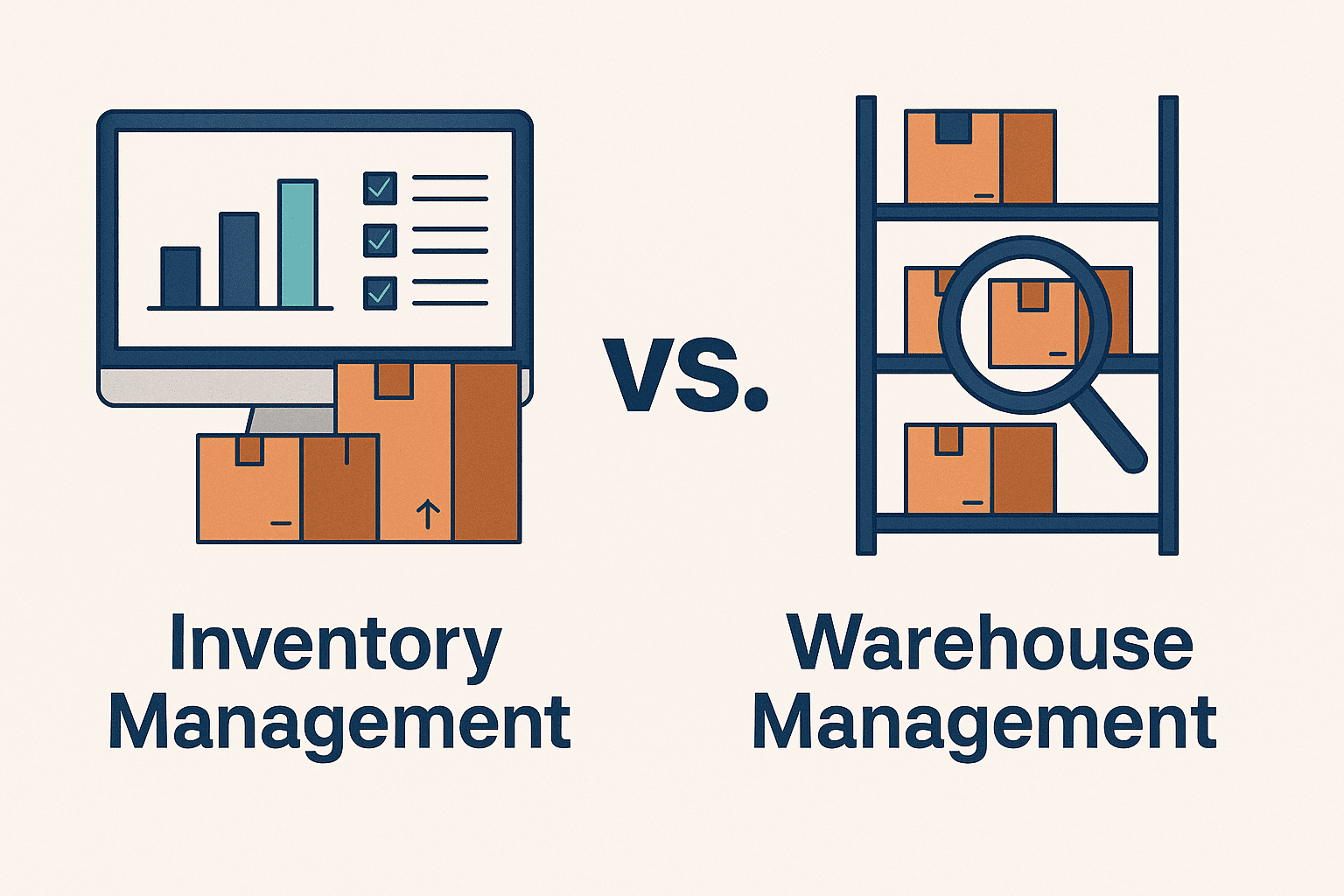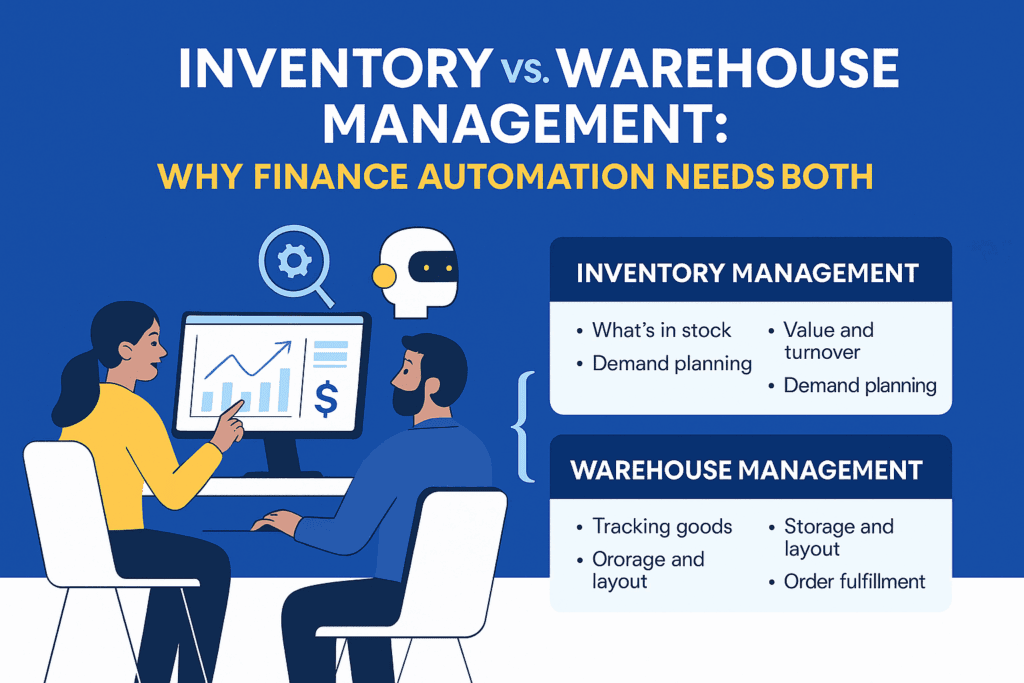In modern finance and procurement, the terms “inventory management” and “warehouse management” are often used interchangeably — but they are far from the same. Confusing the two can lead to inefficiencies, poor visibility, and missed profit opportunities.
If you’re relying on manual systems or legacy tools, you might not even realise where the leak is occurring. This blog will outline the key differences between inventory and warehouse management, explain why both are vital for automation-led financial control, and show how tools like AP Flow help bridge the gap — from sourcing to fraud detection.
What’s the Difference between Inventory vs. Warehouse Management?

Inventory management is about the “what” — what products or materials you have, how many, and when they need replenishing. It’s a finance-focused function directly tied to cost control, stock valuation, and profitability.
Warehouse management, on the other hand, is about the “where” — where items are located, how they move within the warehouse, and how efficiently operations run. It deals more with logistics, space, and internal movement.
✅ Think of inventory as what’s on the books.
✅ Warehouse is how it’s on the shelf. .
Without visibility into both, teams often make poor decisions — such as over-ordering items already in stock, or missing discounts because products weren’t logged correctly.
Why Finance Should Care
Finance teams often assume this is “ops work.” But poor coordination between inventory and warehouse processes leads to:
- Missed early payment discounts
- Inaccurate budget forecasts
- Overstocking or understocking
- Unjustified supplier disputes
All of which affect your bottom line.
That’s where automation comes in — and why finance, procurement, and operations teams need to work from the same source of truth.
Automation Creates Real-Time Visibility (Not Just Reports)
Relying on spreadsheets or disconnected systems means you’re always a few steps behind. But with Medius Copilot, real-time dashboards provide finance and procurement teams with a clear view of:
- Inventory movement versus budgeted spend
- Delayed warehouse transfers impacting invoice approvals
- Supplier order status, instantly
This level of visibility enables teams to prevent errors before they occur, rather than reacting afterwards.
Connecting Inventory to the Procure-to-Pay Flow
Picture this: a warehouse receives goods but fails to log them correctly. The finance team never receives confirmation. Meanwhile, a duplicate invoice slips through.
Without connected systems, these issues often go unnoticed.
With AP Flow’s Fraud Risk Detection, mismatches between purchase orders, invoices, and deliveries are automatically flagged. You’re not just detecting fraud — you’re preventing profit leaks from the outset.
Smarter Sourcing Starts with Smarter Stock Insights
How can you negotiate better supplier contracts without knowing your real-time stock levels?
Manual sourcing often overlooks warehouse realities — resulting in:
- Ordering items you already have
- Missing out on bulk discounts
- Committing to slow or costly vendors
With AP Flow’s Sourcing module, your procurement team can align current inventory needs with live supplier data. Through side-by-side comparisons and automated RFP scoring, you’re not just purchasing — you’re purchasing strategically.
Supplier Conversations That Actually Save Time
How many times have you emailed a supplier asking, “Has this order been dispatched?” or “Have you received our payment?”
Now multiply that by 50 suppliers.
Manual communication doesn’t just waste time — it creates misalignment between what’s in stock, what’s in transit, and what’s been paid for.
That’s where Supplier Conversations make the difference. By centralising supplier updates, alerts, and reminders, finance and operations teams remain aligned — automatically.
Result? Fewer delays. Clearer records. Stronger vendor relationships.
Real-World Consequences of Misalignment
Still not convinced? Here’s what happens when inventory and warehouse systems aren’t connected:
- Finance teams overestimate the cost of goods sold (COGS)
-
Discounts are missed due to delayed approvals
- Duplicate orders build up because previous deliveries weren’t visible
- Audits fail owing to incomplete stock verification
The cost? Easily 0.3–0.7% of your annual expenditure.
✅ Why You Need Both (and How AP Flow Helps)
This isn’t about choosing between inventory or warehouse management. Real financial visibility demands both — integrated with your procurement systems. Here’s how AP Flow helps close the loop:

📞 Ready to Bring Visibility to Your Spend?
If you’re finding it difficult to connect your inventory, warehouse, and finance workflows — you’re not alone.
Let us help simplify things.👉 Speak to our team for a free assessment on how AP Flow can close your visibility gaps and boost spend efficiency.

